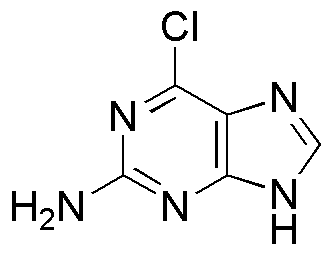6-Chloroguanine is widely utilized in research focused on:
- Antiviral Research: It serves as a key compound in developing antiviral drugs, particularly against viruses like HIV and hepatitis, due to its ability to inhibit viral replication.
- Cancer Treatment: This compound is explored for its potential in cancer therapies, especially in targeting specific types of tumors, by interfering with DNA synthesis in rapidly dividing cells.
- Genetic Studies: Researchers use it to study mutagenesis and the effects of DNA damage, providing insights into genetic disorders and the mechanisms of mutation.
- Pharmaceutical Development: It acts as a building block in synthesizing other pharmaceutical agents, enhancing the efficiency of drug development processes.
- Biochemical Research: The compound is employed in various biochemical assays to understand enzyme mechanisms and cellular processes, contributing to advancements in biochemistry.
General Information
Properties
Safety and Regulations
Applications
6-Chloroguanine is widely utilized in research focused on:
- Antiviral Research: It serves as a key compound in developing antiviral drugs, particularly against viruses like HIV and hepatitis, due to its ability to inhibit viral replication.
- Cancer Treatment: This compound is explored for its potential in cancer therapies, especially in targeting specific types of tumors, by interfering with DNA synthesis in rapidly dividing cells.
- Genetic Studies: Researchers use it to study mutagenesis and the effects of DNA damage, providing insights into genetic disorders and the mechanisms of mutation.
- Pharmaceutical Development: It acts as a building block in synthesizing other pharmaceutical agents, enhancing the efficiency of drug development processes.
- Biochemical Research: The compound is employed in various biochemical assays to understand enzyme mechanisms and cellular processes, contributing to advancements in biochemistry.
Documents
Safety Data Sheets (SDS)
The SDS provides comprehensive safety information on handling, storage, and disposal of the product.
Product Specification (PS)
The PS provides a comprehensive breakdown of the product’s properties, including chemical composition, physical state, purity, and storage requirements. It also details acceptable quality ranges and the product's intended applications.
Certificates of Analysis (COA)
Search for Certificates of Analysis (COA) by entering the products Lot Number. Lot and Batch Numbers can be found on a product’s label following the words ‘Lot’ or ‘Batch’.
Numéro de catalogue
Numéro de lot/série
Certificates Of Origin (COO)
This COO confirms the country where the product was manufactured, and also details the materials and components used in it and whether it is derived from natural, synthetic, or other specific sources. This certificate may be required for customs, trade, and regulatory compliance.
Numéro de catalogue
Numéro de lot/série
Safety Data Sheets (SDS)
The SDS provides comprehensive safety information on handling, storage, and disposal of the product.
DownloadProduct Specification (PS)
The PS provides a comprehensive breakdown of the product’s properties, including chemical composition, physical state, purity, and storage requirements. It also details acceptable quality ranges and the product's intended applications.
DownloadCertificates of Analysis (COA)
Search for Certificates of Analysis (COA) by entering the products Lot Number. Lot and Batch Numbers can be found on a product’s label following the words ‘Lot’ or ‘Batch’.
Numéro de catalogue
Numéro de lot/série
Certificates Of Origin (COO)
This COO confirms the country where the product was manufactured, and also details the materials and components used in it and whether it is derived from natural, synthetic, or other specific sources. This certificate may be required for customs, trade, and regulatory compliance.


